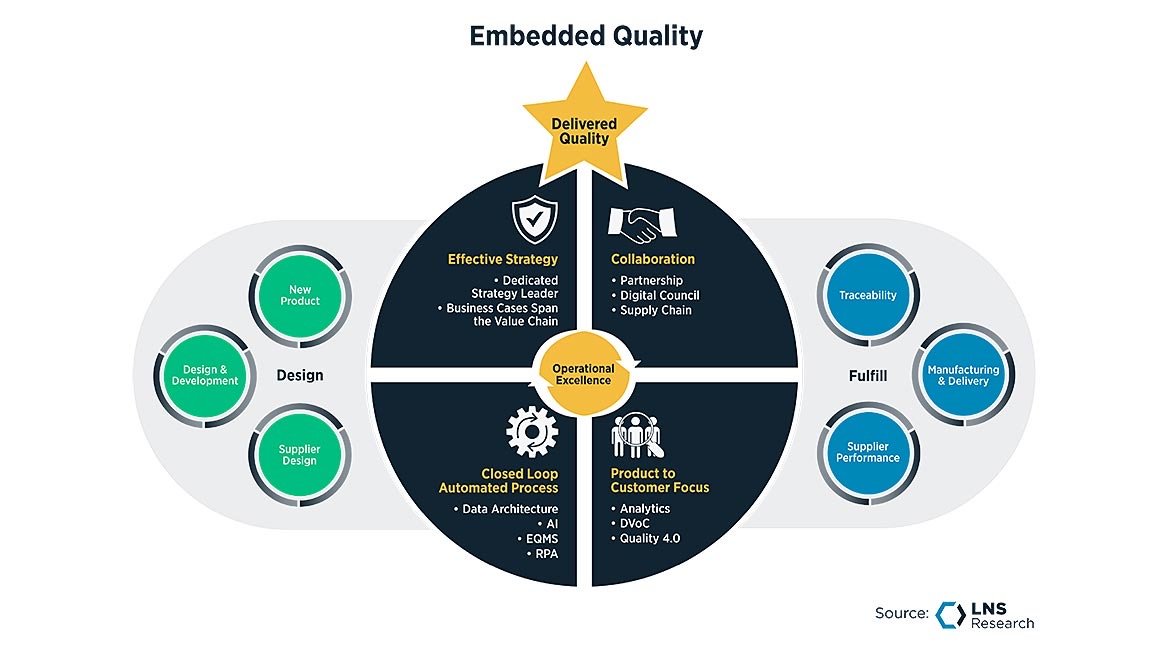Embedded Quality: Create Competitive Advantage and Customer Delight
How can I do more with my quality management processes?
Quality issues in manufacturing continue to top the headlines with product failures and recalls. This article shares the latest insights on embedded quality, the critical elements of a successful strategy, and what quality leaders are doing to achieve real business impact. Learn why delivered quality is your North Star and what that means for your organization.
The Costly Quality Crisis
Many manufacturers and their suppliers have to deal with quality issues. For instance, recent research shows that when you look across the FDA, Department of Transportation and Consumer Life Sciences, when we look at all those recalls, there has been a 47% increase from the end of the pandemic in 2021 to 2023. And 2024 is shaping up to be even higher than the record of 2023.
The funny thing is that all these leading companies and their suppliers have sophisticated quality management systems in place. What is going wrong, and what can we do about it?
Dr. Joseph A. DeFeo, renowned authority on quality leadership and operational excellence: “Maybe it’s not leadership, but complacency because they think their quality system is good. One thing about all these companies is, they’re all registered to a third-party audit system. They are audited frequently, and they are passing the grade. The reality is all the quality management audits internal and external are qualitative. And that is not enough. You need to look into the numbers. Look into the things we’re supposed to be doing here against the things we do. Therein probably lie the failures that we see on such a scale.”
Numbers game
DeFeo advocates adding a quantitative dimension to the audit process: “Quantitative meaning: these are the metrics that are important to us. Show me what you’re doing to drive those metrics. And if you don’t have a good product quality control process, you’re probably never going to get there. You can have the greatest lean implementation, but you’re not going to get there because there are things missing. For just meeting customer requirements and making the company profitable due to less defects, less deficiency, less failure, you have to address your quality management system and try to make it more quantifiable.”
Market Information
Research companies in the market are on the same page, like LNS Research. Their research shows the top drivers that industrial companies face today when it comes to quality. And how those quality leaders can impact not just compliance, but deliver results to shareholders, other stakeholders and most importantly to customers.
For chief quality leaders the main objective is to partner effectively with business leaders and help them not just build quality into what they’re trying to achieve, but also help them achieve their business outcomes. At the same time, there’s tremendous pressure to reduce both the cost of poor quality and the cost of good quality.
In other words, how can I do more with my quality management processes?
LNS Research shows that during COVID demand reduced and inflation increased. Which hit manufacturers hard through their cost of labor, energy, maintaining assets and materials.
As manufacturing is a cyclical industry, it will recover, but it still has to be more efficient, more effective in managing cost across the quality team, developing the team, the skills of the team, making sure that the team is empowered. Also making sure that those in engineering, procurement, manufacturing and customer service all understand quality, the value of quality to the customer and to the overall value chain.
Empowerment and upscaling of the quality team must be top of mind for leadership.
Many companies have a great culture of quality and really do prioritize the customer and customer experience and see quality as both enabler and competitive advantage. But that’s not everybody. And thus, quality leaders and chief quality officers sometimes have to do a fair bit of selling up to C-level.
In the last couple of years, we also experienced a changing workforce due to a large retiring workforce who have been in the job for a very long time. They are now being replaced by a workforce with two, three and four years of work experience.
Another root cause for the current quality crisis is that management focus has shifted to other matters, such as profitability, productivity, efficiency and cost reduction. Sometimes at the expense of things like quality. There has been a decline in the quality management function over the last 30 years, in terms of how many people are doing quality. Companies started to scrap education, removed experience and reduced knowledge of how to manage for quality and replaced it with organizational systems. The highest-level quality professional in a company nowadays did not necessarily grow up in the manufacturing process. And if you don’t have that deep understanding of cause and effect in production, it’s very hard to manage quality.
These are some of the challenges that companies in general are facing and quality leaders have a big role to play in addressing them.
Quality leadership is a choice
Remember to craft your message around quality in a way that resonates and drives a vision that brings management to act. It is about enhancing customer delight. Therefore, management should have skin in the game.
One thing that can be done easily is for leadership to identify someone on the leadership team who is going to be the true management champion for the quality management system. And that connection is very important because right now it’s down to operational levels and we want to strive for embedded quality at every level.
Choose wisely
Start with the customer. What do they want? Honestly, customers don’t care much about anything that’s beyond the product or service they buy. Then get the right quality metrics and choose your digital quality management system wisely.
At the moment there are still many manufacturers that depend on Excel or even paper-based systems.
You will be wasting your time if you do not start with some type of digital quality management system. QMSs are now very affordable compared to ten years ago. Even for smaller companies, there are affordable quality management systems that you could start with. Look for a system that allows input and capture of data in near real-time for analysis and combining both data and documents. And make sure that it is able to expand in the future.
Summary
When manufacturing companies align their quality management systems with strategic business objectives, they unlock substantial benefits. To integrate quality management deeply and seamlessly, promoting consistent adoption and participation leads to a culture where quality is not an afterthought or a checkbox but an intrinsic part of daily operations that contributes directly to business success.
When you as a quality leader want to be seen as an internal business partner make your message about the business outcomes that are tied to customer experience and tied to competitive advantage, then you’re talking C-level language!
For a webinar with DeDr. Joseph A. DeFeo, watch https://alisqi.webinargeek.com/quality-talks-episode-3-1?cst=blogpost.


